March 30, 2007
Air Date: March 30, 2007
FULL SHOW
SEGMENTS
Endangered Species Rollback?
View the page for this story
A document leaked from the Fish and Wildlife Service calls for changes to the Endangered Species Act that would dramatically curtail the protections the act offers. Host Bruce Gellerman talks with reporter Rebecca Clarren, who was leaked a copy of the report and wrote about it for Salon.com. Living on Earth then turns to a spokesman from the Fish and Wildlife Service for a response. (06:00)
Earth's Crust Section Gone
View the page for this story
Researchers aboard the RRS James Cook have set out to determine exactly why a section of the earth's crust is missing along the Mid-Atlantic Ridge. Geophysicist and mission leader Roger Searle of Durham University speaks to host Bruce Gellerman from his ship cabin. (05:15)
Hot As Hell?
/ Bruce GellermanView the page for this story
Host Bruce Gellerman reports on a new study that measures, for the first time, the temperature 2,400 miles deep into the earth. (02:00)
EPA's Watchdog Budget Cuts
View the page for this story
The Bush administration is proposing budget cuts to the U.S. Environmental Protection Agency's Office of the Inspector General. Several leading members of Congress are concerned that some agency staff members are being offered buyouts before Congress has even acted on the budget. “Inside EPA” Managing Editor Anthony Lacey talks with host Bruce Gellerman about the proposed cuts. (05:30)
Microbe's Big Role
/ Ian GrayView the page for this story
A committee from the National Academy of Sciences has issued a report calling on the federal government to fund a ten-year effort to study the genomes of microbe communities. “Metagenomics” is a new field which analyzes the role micro-organisms play in regulating the health of the planet. Living on Earth’s Ian Gray reports. (06:00)
Emerging Science Note/Flexing Glass
/ Meghan VigeantView the page for this story
Glass that bends? Meghan Vigeant reports. (01:30)
Interfaith Climate Walk
View the page for this story
Folks of faith, from Buddhists to Evangelical Christians and everything in between, gathered to walk across Massachusetts to call for action on global warming. Living on Earth was there and recorded these sounds. (05:25)
Endangered Elephants
View the page for this story
Twenty years after an international treaty banning the trade of ivory, ivory smuggling is alive and well. Samuel Wasser of the Center for Conservation Biology at the University of Washington tells host Steve Curwood why the 1989 ban on ivory has failed and what can be done to end the slaughter of the world’s largest terrestrial mammal. (10:00)
Climate Change Not So Sweet
/ John DillonView the page for this story
Maple sugar makers are learning first-hand the effects of global warming. Mild winters and early sap runs are forcing many producers to try new techniques to adapt. Vermont Public Radio’s John Dillon went out with a seventh generation maple sugarer on a tap run and has our story. (06:30)
This week's EarthEar selection
listen /
download
Elephants snooze in Maasai Mara, Kenya.
Show Credits and Funders
Show Transcript
HOST: Bruce Gellerman
GUEST: Rebecca Clarren, Anthony Lacey, Chris Tollefson, Roger Searle, Samuel Wasser
REPORTER: Ian Gray, John Dillon
SCIENCE NOTE: Meghan Vigeant
[THEME]
GELLERMAN: From Public Radio International - this is Living on Earth.
[THEME]
GELLERMAN: I’m Bruce Gellerman. Is the Endangered Species Act in danger? A draft report leaked from the US Fish and Wildlife Service suggests the Bush Administration is trying to weaken the law and worker morale in the agency is suffering.
CLARREN: One man told me, who’s recently retired, which is why he could talk on the record, told me, we’re like a bunch of whipped dogs at the agency these days.
GELLERMAN: Also- elephant poaching is way up as an international ban on the ivory trade breaks down.
WASSER: There’s story after story of elephants who have died and how the other elephants just stand around it for hours, even days, incredibly distressed. So when we rip apart their families from poaching, we’re doing much much more than people really appreciate.
GELLERMAN: And scientist search for a missing piece of the Earth’s crust. These stories and more, this week on Living on Earth. Stick around!
[NPR NEWSCAST]
ANNOUNCER: Support for Living on Earth comes from the National Science Foundation and Stonyfield Farm.
[THEME]
Endangered Species Rollback?
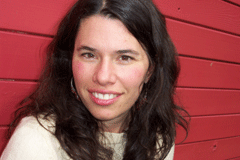
Rebecca Clarren (Courtesy of Rebecca Claren)
GELLERMAN: From the Jennifer and Ted Stanley Studios in Somerville, Massachusetts - this is Living on Earth. I’m Bruce Gellerman.
The federal Endangered Species Act is one of the nation’s most powerful and controversial environmental laws. Listing an animal as endangered can silence chain saws and stop bulldozers dead in their tracks.
For years there have been efforts in Congress supported by the Bush Administration to loosen the constraints of the law on landowners and industry. These efforts have all failed, but now it seems that at least some officials of the agency responsible for enforcing the Endangered Species Act would like to change the way it’s implemented and without the ok from congress. The plan is detailed in a secret draft report that’s been circulating within the US Fish and Wildlife Service.
Rebecca Clarren, a freelance reporter got her hands on a leaked copy and wrote about it in Salon dot com. She joins us from Portland, Oregon. Hi Rebecca.
CLARREN: Hi there. How are you?
GELLERMAN: I’m well but according to your article in Salon.com the Endangered Species Act is in trouble. Tell me about these proposed changes.
CLARREN: Well, the number of species that would be protected would be limited, the number of acres of wildlife habitat that could be preserved would be curtailed. State governments would have the authority and the opportunity to take over the act from the federal government. At the end of the day Fish and Wildlife Service would have a lot less power to do what congress asked them to do which was to protect fish and wildlife from going extinct.

Rebecca Clarren (Courtesy of Rebecca Clarren)
CLARREN: Well, right now when the service sets out to decide how to make sure if an animal is deserving of landing on this list and getting federal protection, they’ll look at, into the foreseeable future how likely is it that a species is going to die out. Foreseeable future is a nonspecific term; it could be 30 years, it could be 300 years. So instead it narrows that definition. It says foreseeable future actually means, regardless of what species we’re talking about, it means twenty years or ten generations. And why that’s troubling is twenty years! Think about species like orca whales or grizzly bears or wolves. Well, they live a long time. So how is it in twenty years they’re going to go extinct. It’s not. My sources told me that a vast majority of species currently on the Endangered Species Act, under this new regulatory change, wouldn’t be eligible to wind up with federal protections.
GELLERMAN: Well, what about shifting the authority to enforce the act from the federal government to the states?
CLARREN: We have a history, especially here in the west, of conservative state governments not wanting to protect endangered species because to do that often has meant not allowing logging or mining or some natural resource extraction to go forward. So state governments haven’t demonstrated the will to protect endangered species. It’s why we created, as a nation, the act in the first place in the 1970’s.
GELLERMAN: Now, protecting species means, really, protecting habitats. How would this dilute the legal barriers that protect habitats?
CLARREN: That’s a great point. So right now, you know, under current regulations when you’re looking at how to reintroduce a species or make a species come back from the brink of extinction, you look at protecting wide chunks of landscape or rivers and streams to give species that sort of breathing room to come back. And yet under the proposed regulation it would change it from looking at where they historically were, when they were a thriving population, to where they are now. And so if you decide that they’re only going to get protected in the range where they are, that’s a way of just maintaining the status quo. It doesn’t give them that opportunity to re-grow their historic population base.
GELLERMAN: I can’t imagine that people that are in the Fish and Wildlife Service, at the grassroots level, think much about this.
CLARREN: No. I’ve actually heard from a number of sources that it’s a pretty grim feeling there at the agency. I think in many ways that’s why I was leaked a copy. One man told me, who’s recently retired which is why he could talk on the record, said we’re like a bunch of whipped dogs there at the agency these days.
GELLERMAN: Where do these ideas come from, Rebecca?
CLARREN: Well, I think it is no secret that this administration has never been a huge fan of the Endangered Species Act. Um, So they appointed Dirk Kempthorne, who was Idaho governor and was also served as senator from Idaho in the late 90’s and this is a man who has never been a fan of endangered species protections in his state. He wrote some legislation that would have really over hauled the Endangered Species Act back then that congress shot down. But a lot of the regulatory changes come from that. They also, looks like a lot of the language is lifted directly from a very contentious bill by Pombo, a congressman from California, former congressman, that was also shot down in congress. So you’re seeing the Bush administration trying to insert into regulatory changes, things that congress has already decided we, as a country, didn’t want to see.
GELLERMAN: Rebecca Clarren is a frequent contributor to Salon.com. Rebecca, thank you very much.
CLARREN: Thank you so much.
GELLERMAN: Rebecca Clarren’s article about proposed changes to the endangered species act appears on Salon dot com and was based upon leaked documents from the Fish and Wildlife Service. We called the agency for comment and got this response from spokesman Chris Tollefson.
TOLLEFSON: All of us recognize that the ESA is one of the most important environmental laws ever enacted. But there’s also a recognition that every law could be improved. And so, you know, the secretary came to us as an agency and said, “You know, take a look at it and see what you can do.” This is nothing that is happening under the radar, this is how we always develop policies and regulations. This will be a very public process.
GELLERMAN: U. S Fish and Wildlife spokesman Chris Tollefson. After this story broke, the chair of a key congressional committee told the Director of the Agency that only Congress can make fundamental changes to the Endangered Species Act.
[MUSIC: The Octopus Project “Rorol” from ‘Identification Parade’ (Peek-A-Boo – 2002)]
Related links:
- Rebecca Claren's article in Salon.com
- To read the draft leaked by the U.S. Fish and Wildlife Service click here.
Earth's Crust Section Gone
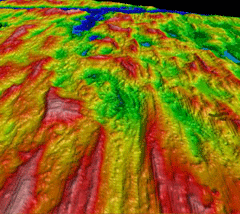
An 'aerial' view of part of the study area. This is on the Mid-Atlantic Ridge at 14ºSA, looking south. (Courtesy of The Classroom@Sea Project)
GELLERMAN: If Sherlock Holmes was on the trail he might call it:
“The Case of the Missing Crust” It seems scientists can’t find a giant piece of the earth's crust. It’s supposed be in the ocean part of the Mid-Atlantic ridge several thousand square kilometers down, but it’s missing.
[MUSIC: The Crazy World of Arthur Brown “Fire!” from ‘Fire! The Story of Arthur Brown’ (Castle Recordings - 2003)]
Scientific sleuths from Britain’s National Oceanography Research Center have set sail with special sonar and deep-sea drilling equipment in search of clues to solve the mystery. Joining us from his cabin aboard the R-R-S James Cook is mission-leader and geophysicist Roger Searle, of Durham University.
Professor Searle, good to speak to you.
SEARLE: Yes. Good to speak to you to.
GELLERMAN: Where are you right now?
SEARLE: Halfway between the island of Tenerife and the island of Barbados.
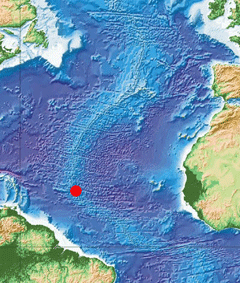
"Image of the Mid-Atlantic Ridge. You can see how the ridge is broken up into segments by fractures running roughly perpendicular to the ridge axis. The red dot shows the area where the team on board the ship will be working." (Courtesy of The Classroom@Sea Project/GEBCO)
SEARLE: Well, I should probably explain what we mean by that. Normally we think that the oceanic crust is made up of about seven or eight kilometers thickness of volcanic rocks, which are essentially the results of magma cooling down and solidifying. Now, over the past ten or fifteen years, a succession of researchers in this region have found that when they sampled the sea floor they were not finding many of these kinds of volcanic rocks that they expected. But what they were finding instead was rocks which are typical of the Earth’s mantle. So it looks as though for some reason that volcanic crust is not here. That’s one of the things we’re trying to confirm at the moment.
GELLERMAN: Are there other areas in the world’s oceans where it’s missing?
SEARLE: Um, there probably are. I think that when we first wrote the proposal to do this study this was certainly the best known of such areas at the time. And since then we’ve discovered there are other areas. Some are in the southwest Indian Ocean and in particular very extensive areas of missing crust, if you like, have been found in the Arctic.
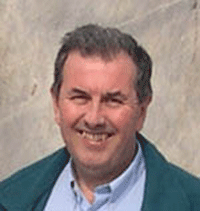
Professor Roger Searle (Courtesy of The Classroom@Sea Project)
SEARLE: Well the outer part, what makes up the tectonic plates or what we technically call the lithosphere, this is a very strong rigid shell, which floats right at the surface of the Earth. And then below that is the mantle and the mantle is not quite as strong so although it’s mostly a solid it can move very very slowly like ice moving in a glacier or something like that. Now, the lithosphere, the solid plates at the top is made of both of the very upper most part of the mantle and this thin layer on top which is the crust. And the difference between them is that the crust is chemically distinct.
GELLERMAN: So where did the crusts go?
SEARLE: Well, I mean there are two options. Either it was formed and it went somewhere else or maybe there are three options. One is it never formed at all, or one is that there was some melting taking place, which would normally lead to formation of the crust. That melt never actually got up to the sea floor so we don’t see it.
GELLERMAN: Does this help us in any way with other parts of our understanding or applied understandings of geology in the Earth’s crust?
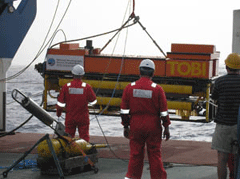
TOBI (Towed Ocean Bottom Instrument - right) is used to build up images of the seafloor surface so that suitable drilling sites can be selected.(Courtesy of The Classroom@Sea Project)
GELLERMAN: Is a missing piece of the Earth’s crust a problem?
SEARLE: I don’t think it’s a problem. No, it’s still solid sea floor at the bottom at the bottom of the ocean. The water’s not going to drain away. It’s a problem for scientists just to understand how that happens.
GELLERMAN: It’s not like pulling the plug in a bathtub.
SEARLE: It’s not like pulling the plug at all, no.
GELLERMAN: Well Professor Searle thank you very much. Appreciate it.
SEARLE: Ok, thank you. Cheerio
Related link:
The Classroom@Sea Project: Drilling the Mid-Atlantic Ridge
Hot As Hell?
GELLERMAN: Geophysicist Roger Searle is aboard the RRS James Cook He’s trying to figure out what happened to a missing piece of the earth’s crust beneath the Atlantic Ocean. Professor Searle’s research reveals the many gaps in our understanding of what happens deep within the earth where intense heat powers nearly all of the planet’s geological processes.
Exactly how hot is it down there? That’s a question scientists and theologians have been asking for centuries. Well, now, MIT geo-physicist Rob Van der Hilst has the answer and it’s published in the latest edition of Science magazine. His team used seismic waves to make the first direct measurements of the temperatures at the region where the mantel meets the molten outer core of the earth - 18 hundred miles down. They report it’s a sin scorching 7000 degrees Fahrenheit
It’s ground breaking research and it’s helped give the study of deep Earth Science the big mo! And later this year Japanese researchers will begin drilling four miles into the earth by far the deepest probe into our planet yet. It’s a half billion dollar effort in search of answers to that most fundamental of questions just what the hell is going on down there?
[MUSIC: The Crazy World of Arthur Brown “Fire!” from ‘Fire! The Story of Arthur Brown’ (Castle Recordings - 2003)]
GELLERMAN: Coming up: the brave new world of metagenomics promises to revolutionize biology. That’s just ahead on Living on Earth.
[MUSIC: Tuxedomoon “A Home Away” from ’20 Ways To Float Through Walls’ (Crammed Disc US – 2007)]
EPA's Watchdog Budget Cuts
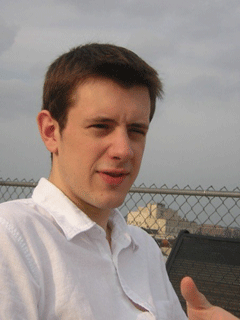
Anthony Lacey (Courtesy of Anthony Lacey)
GELLERMAN: It’s Living on Earth. I’m Bruce Gellerman. Earlier in our show we told you about a secret proposal that could weaken the Endangered Species Act. Well, also from Washington this past week comes news of a move that could weaken enforcement of anti-pollution laws. The independent office that serves as the watchdog for the U.S. Environmental Protection Agency is being put on a shorter leash, and may lose some of it’s bite. The budget of the office of the Inspector General at the EPA is being cut. Some critics charge the cut is politically motivated.
Joining me is Anthony Lacey. He’s managing editor of the publication "Inside EPA." Anthony, welcome to Living on Earth.
LACEY: Thanks.
GELLERMAN: Let me ask you first before you even talk about these cuts is what does the office of the inspector general do at the EPA?
LACEY: It’s the independent branch that reviews audits and investigates EPA on a range of subjects, particularly rule makings that the agency comes out with. It’s kind of the independent check on the agency within the agency.
GELLERMAN: I understand there are about 360 people who work in this office of inspector general right now. They want to cut what ten percent of the funding and 30 jobs.
LACEY: Right the proposal for fiscal year 2008 would be a 5.1 million cut to the office’s funding.
GELLERMAN: You know in terms of federal spending though five million dollars doesn’t sound like much money.
LACEY: Right, the criticism though is that 30 employees that’s a significant amount of expertise.

Anthony Lacey (Courtesy of Anthony Lacey)
LACEY: That is the major concern that’s coming out of John Dingell’s office. And he’s joined in that concern by several of the Democrats on the House Energy and Commerce committee that he chairs, as well as the ranking Republican on the committee, John Shimkas. And their concerns are that Congress hasn’t even acted on this budget - the House or the Senate haven’t passed their versions of the EPA spending bill. And these job cuts, and the budget cuts as well, it’s all in the proposed budget. And so they’re questioning where is the authority coming from to go ahead with these job cuts. The signal is that acting Inspector General, Bill Roderick is pressing ahead with staff buyouts and trying to implement these job cuts.
GELLERMAN: So it would be a fait accomplis?
LACEY: That’s the exact phrase John Dingell used to describe it, yeah.
GELLERMAN: How was it done in preceding budget years?
LACEY: In previous budget years the office has received cuts, but at the same time it’s kept up its investigations of the agency. Under the former inspector general, Nikki Tinsley, who resigned last March, the agency did a lot of reviews which were fairly critical of EPA rule makings.
GELLERMAN: So are you suggesting that this is pay back to the office of the inspector general for being too tough?
LACEY: Personally, I obviously couldn’t suggest that but the, I have spoken with some significant Democratic members of Congress and activist people off The Hill as well who have great expertise with this, including some former agency officials. And they have suggested that this may indeed be payback to get back at the Inspector General for its previously scathing reports on some of the EPA’s rule makings.
GELLERMAN: So the President has proposed a budget for fiscal year 2008 which would call for this cut. I mean the EPA’s gotta cut someplace then, so why not here?
LACEY: Well, the point that the Democrats are trying to make is that Congress could well boost EPA’s budget when they begin debate on the House or Senate floor on EPA’s spending bill for fiscal year 2008. In fact in John Dingell’s letter to Bill Roderick in which he raises concerns about these IG cuts he mentioned his concern that if Congress does not approve the budget cuts for the office of Inspector General that Roderick’s ongoing buyout of the staff could cause unnecessary loss of experienced personnel. So, essentially what he’s saying there is let’s wait for Congress to act because Congress may end up restoring that cut to the office of Inspector General and also not approving this proposal to cut 30 jobs.
GELLERMAN: So, what’s the next chapter in this saga?
LACEY: I think continued scrutiny from the Democrats on this issue particularly in the House Energy Committee. And some people have told me that you may also see action on the House floor to block funding for EPA to implement these job cuts.
GELLERMAN: Anthony Lacey is Managing Editor of Inside EPA. We spoke with him from his office in Arlington, Virginia. We also contacted the EPA's acting Inspector General Bill Roderick to discuss the budget cuts to his office. We were told he was, quote: "unavailable for comment."
[MUSIC: Pinetop Seven “Untitled” from ‘The Night’s Bloom’ (Empyrean Records - 2005)]
Related links:
- U.S. EPA Office of the Inspector General
- Inside EPA
- The letter sent to Acting Inspector General Bill Roderick from the House Committee on Energy and Commerce Chairman, John Dingell
- The email Acting Inspector General Bill Roderick sent his employees on February 9, 2007 in regards to the proposed upcoming budget cuts
Microbe's Big Role
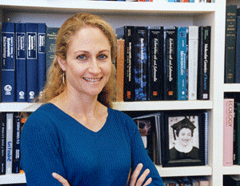
Professor Joe Handelsman (Courtesy of the University of Wisconsin-Madison)
GELLERMAN: In the 1990’s the federally funded Human Genome Project set out to map every strand of human DNA. It succeeded and vastly increased our understanding of how genes function.
Now the study of genes is moving toward a new frontier. A committee of the National Academy of Science has just released a report on a brand new field that promises profound insights into the little known world of microorganisms. Living on Earth’s Ian Gray has this introduction to the brave new world of metagenomics.
GRAY: Remember the saying that it’s the little things that hurt? Well, it turns out that little things also help and some little things help out a lot.
HANDELSMAN: Microbes are incredibly important they run essentially every process on earth either directly or indirectly.
GRAY: That's Jo Handelsman. She’s a microbiologist at the University of Wisconsin in Madison. She studies the bacteria, algae, archaea and other tiny creatures that together are known as microorganisms—or microbes.

Professor Joe Handelsman (Courtesy of the University of Wisconsin-Madison)
GRAY: And less is known about microbes than just about any other forms of life on earth. What is known is that there’s a tremendous amount of microbial life out there and that a lot of it provides services and performs functions that are very useful to humans. Microbes help in the digestion of food, they process sewage, they even can help clean oil spills.
That’s why Handelsman is so excited about the possibilities presented by the new field of Metagenomics.
HANDELSMAN: Metagenomics may be the most important event in microbiology since the invention of the microscope. And although that sounds extreme, it is an entirely new way of studying microorganisms and it gives us a completely different picture than by any of the previous methods that we use.
GRAY: Until recently, microbes, and what microbes do, were generally studied in isolation, one by one, in a lab, often by splicing up and studying their DNA. But metagenomics takes samples of an entire local ecosystem and examines all of the microbes that live there together. Essentially, it looks at their collective genome.
HANDELSMAN: The biggest difference of metagenomics and sequencing an individual species like the human genome or a plant genome is the complexity of the DNA. We may have millions of different types of bacteria or microorganisms in a single sample.
GRAY: By analyzing the DNA of all microorganisms, in a teaspoon of soil for instance, scientists can determine how many new species the sample contains. Then begins the laborious process of figuring out what all the genes actually do, what proteins they code for and what functions they serve.
Metagenomics has emerged as recent breakthroughs in technology that have made it far cheaper and easier to sequence genes. One of the people responsible for this is Craig Venter, the scientist who raced the federal government to be the first to map the human genome. Venter’s lab perfected a method of genetic analysis called “shotgun sequencing” that allows thousands of strands of DNA to be analyzed at once.
Now Venter’s helping to mainstream metagenomics by living one of its basic principles: he’s gotten out of the lab and into the environment.
VENTER: We’re in the Sea of Cortez and we’re just heading around an island out to sea to sail further down toward the Pacific Ocean.
GRAY: Not a man of small ambitions, Venter is now circling the globe in his ship, the Sorcerer Two, collecting microbial life from the ocean.
His method is simple: Every 200 miles, they haul up a few buckets of seawater. Then, they take all of the organisms in the bucket, most of them invisible to the human eye, and use shotgun sequencing to fragment and read their DNA.
VENTER: The main question was whether we’d find unique diversity, everywhere we looked, or whether what many people thought that the ocean was just one giant homogenous soup.
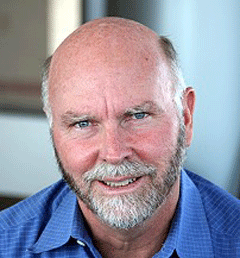
J. Craig Venter (Courtesy of U.S. EPA)
VENTER: We found that 85% of the sequences from each site assembled were unique which means that the relative organisms that are there are totally unique to those sites, you know, each two hundred liters of sea water can have 40,000 new species in it that we haven’t seen
GRAY: Now the trick is figuring out how to organize—and analyze—all this data. Metagenomics gives scientists an idea of the number of genes and organisms in a micro-community, but so far it doesn’t help them figure out which genes belong to which organisms what those genes do or what functions those microbes perform.
Jo Handelsman of the University of Wisconsin says that’s a huge challenge.
HANDELSMAN: that’s one of the big road-blocks in metagenomics is taking all of that information about the DNA and putting it back together in some meaningful whole that tells us about the physiology of the community and how it functions and what its life is like, what it responds to, what kind of factors affect it from the outside?
GRAY: Craig Venter’s group is hoping to get a jump on that challenge they’ve helped set up a new database at the University of California at San Diego to house material from the Sorcerer Two expedition. Along with the new genes they’ve discovered, the database includes information like the location of where the sample was collected and the temperature, pH and salinity of the water from which it was taken.
Now a panel from the National Academy of Sciences is calling on the federal government to fund a new ten-year Global Metagenomics Initiative, similar in scale to the Human Genome Project of the last decade. Microbiologist Jo Handelsman was co-chair of the committee. She says metagenomics has the potential to revolutionize our understanding of the world.
HANDELSMAN: It sometimes feels, as a biologist, like we’re just opening the door on biology for the first time.
GRAY: And on the other side of that door, Handelsman says, lies a far deeper understanding of the role that microorganisms play in the environment. Ahead as well she believes may be new ways of harnessing the power of microbes to help tackle problems in human health, food production, pollution and even global warming.
For Living on Earth, I’m Ian Gray.
[MUSIC: “Purer, Softer, Deader?” from ‘Kitchen Motors Family Album’ (Kitchen Motors – 2007)]
Related links:
- National Academy of Sciences Report "The New Science of Metagenomics: Revealing the Secrets of Our Microbial Planet"
- Sorcerer II Expedition
- J. Craig Venter's expedition's work
- J. Craig Venter's Database
GELLERMAN: Just ahead: joining hands across faiths to walk the walk against climate change. First this Note on Emerging Science from Meghan Vigeant.
Emerging Science Note/Flexing Glass
[CRACK OF A BAT]
VIGEANT: Oh No! It looks like it’s headed straight for the…
[SOUND OF GLASS BREAKING]
VIGEANT: Uh oh! Sorry, mom.
Well, that’s what happens when you apply sudden pressure to most glass. Old-fashioned glass is a strangely fragile substance. It’s made of silicon dioxide - sand, that’s melted and then cooled again into a semi-solid state. It’s hard like a solid but its atomic structure is more like a liquid. So when something hits it, it shatters easily.
Scientists have tinkered with the ingredients of glass over the years and have added substances that can make it less quick to shatter. But what if instead of breaking at all, it bent?
Well, scientists at the Chinese Academy of Science have changed the rules of the glass game. They took an existing form of glass containing the metals zirconium, aluminum, copper and nickel and added some new substances - they won’t say what. The result is a glass that bends like copper wire. Atomically it’s made up of hard spots and soft spots. So as you apply pressure instead of cracking the strain is dissipated throughout the whole piece allowing the glass to bend.
Though bendable glass is far from the market, it could mean a whole new ballgame for buildings, safer cars and even better sports equipment. It could be helpful to homes in hurricane and earthquake zones. Well, with prospects like that, I’d say this new bendable metallic glass is batting a thousand.
That’s this week’s note on emerging science. I’m Meghan Vigeant. Now let’s play ball!
[CROWD SOUNDS AND SINGING]
Interfaith Climate Walk
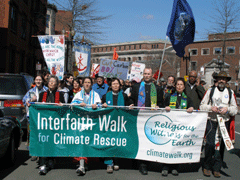
Participants at the Interfaith Walk for Climate Rescue (Photo: Heather E. Snow)
GELLERMAN: You know it’s a movement when faiths come together around a cause. The battles against slavery Jim Crow and the Vietnam War all picked up steam when members of different religions joined the fight.
And so it is today with climate change. Suddenly, in the last year or so, concern about global warming has swept across the nation into houses of worship and onto the streets. A few weeks ago about fifty people of various faiths set out in a blizzard from rural Massachusetts, in a show of interfaith concern about climate change. Over the next week they marched a hundred miles until they reached Boston, 750 people strong. Living on Earth was there when this pilgrimage for the planet reached its destination at the historic New Old South Church.
WOMAN: Welcome, welcome, welcome. This pilgrimage is calling for people of all faiths to be good stewards of this fragile planet and all living beings.
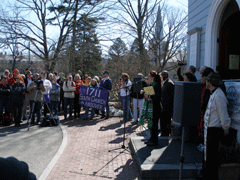
Participants at the Interfaith Walk for Climate Rescue (Photo: Heather E. Snow)
[MUSIC]
MAN: I’m Catholic. It’s a world wide problem. It’s not just here in the United States. It’s not Democrat or Republican, it’s a people issue. Um and we all have to make changes in our day-to-day lives to help to stop this.
MAN 2: Quakers have often been trying to be a voice for the earth that doesn’t have a speaking voice. We firmly believe in the sanctity of all life.
RUBENSTEIN: I was always taught as a Jew that it is our responsibility as humanity to be stewards of the earth, to protect it, to take care of it. And there’s no one else who’s going to do it for us.
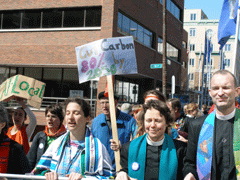
Participants at the Interfaith Walk for Climate Rescue (Photo: Heather E. Snow)
SMALL: All religious traditions call us to care for creation. All religious traditions forbid theft. And climate change is really theft from our own children; theft of a habitable planet. And global warming is a consequence of addiction to material things. So my faith and the faith of more and more people is calling us to act in this world.
MAN 4: In Hinduism there is the concept of duty or dharma I would say is what drives me. And then just I’ve come to accept being active around environmental issues as my duty and that I should further that as my life’s work.
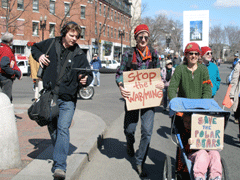
Living on Earth's Dennis Foley struggles to keep pace on this walk while interviewing participants.
(Photo: Heather E. Snow)
JONUS: Because what we’re up against is so enormous it’s really a unique opportunity for the world’s religions to unite in a way they never have before. I think this is a time when people of faith need to really dig deep into their own spiritual resources to really activate in their own lives their own spiritual practices, the deep wisdom of their traditions to look for where is the ecological wisdom that each tradition can bring to the table.
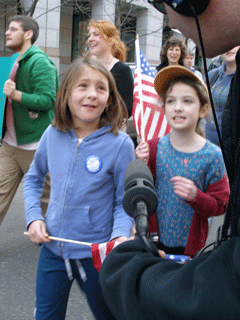
Participants at the Interfaith Walk for Climate Rescue (Photo: Heather E. Snow)
GIRL: My school, I go to a Christian school, and well God gave us the responsibility of taking care of the earth and everyone can join in together on this because it’s not necessarily religious. It can be seen from many different points of views and religion is one of them.
MAN 5: Paganism is, you know, long misunderstood. We’re about honoring the earth, honoring forces of nature. And the earth is our mother.
MAN 6: I’m really into a non-physical entity named Seth. I’m just, you know, doing what I can do to help humanity, you know in a time of crisis.
WOMAN 5: I actually don’t practice any faith. I’m just a spiritual person and I just love the earth and I just I’m happy to live here.
WOMAN 6: I don’t really believe in God or much higher power, but I’m really here to come and support the environment.

Participants at the Interfaith Walk for Climate Rescue (Photo: Heather E. Snow)
SERVICE SERMON PASTOR: God's calling us to insure that efforts to curb global warming prevent further environmental and societal tragedies. As people of faith we are guided by the value of sustainability. But God’s also calling us to leave the planet better than we found it.
[MUSLIM SONG OF PRAYER]
GELLERMAN: You can hear the complete service for the interfaith march for climate rescue at Boston’s New Old South Church on our webpage l-o-e dot o-r-g.
[MUSLIM SONG OF PRAYER]
Related links:
- Interfaith Walk for Climate Rescue
- To hear the entire interfaith service for the environment click here
GELLERMAN: Coming up how sweet it isn’t. Vermonters fear the loss of their beloved sugar maples. That’s just ahead on Living on Earth.
ANNOUNCER: Support for the environmental health desk at Living on Earth comes from the Cedar Tree Foundation. Support also comes from the Richard and Rhoda Goldman Fund for coverage of population and the environment, and from you our listeners, and from member stations. This is Living on Earth on PRI- Public Radio International.
Endangered Elephants
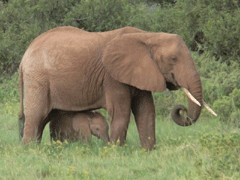
Male baby elephants stay with their mothers until they are about 14. Females live in a familial group with their mothers, grandmothers, sisters and aunts their entire lives. (Courtesy of Richard A. Muller/Lawrence National Laboratory)
GELLERMAN: It’s Living on Earth I’m Bruce Gellerman.
[ELEPHANT CALL]
GELLERMAN: This is the trumpet of an elephant, the world’s largest terrestrial mammal. Listen well because the sound may be lost to future generations. Nearly 20 years after the world came together to ban the international trade of ivory, ivory smuggling is back, big time, and so is the poaching of African elephants. In 2002, officials confiscated 13 thousand pounds of ivory in a single raid, but authorities say the only thing unusual about that incident was that the smugglers were caught. As much as 90 percent of smuggled ivory is never seized.
Samuel Wasser is the director of the Center for Conservation Biology at the University of Washington in Seattle. He recently spoke with Living on Earth’s Steve Curwood about the resurgence of the ivory trade.
WASSER: Actually it is not illegal to sell ivory in any country right now. There was a ban against the sale of ivory in 1989 by the Convention of International Trade and Endangered Species, which is the United Nations entity. But what that really bans is you selling ivory across an international border. So you can buy it on e-bay. You can go into Chinatown in most big cities here and find ivory and it’s all perfectly legal.
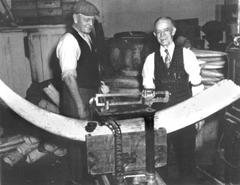
Pratt, Read and Company weigh an ivory tusk circa 1955. (Courtesy of the Town of Essex, CT)
CURWOOD: So when the ban uh on ivory came back in 1989, this was hailed by conservationists as stopping massive elephant slaughter. Now as I understand it things are as bad if not worse than they were back in 1989. What’s happened?
WASSER: Well, first of all you’re absolutely correct that in 1989, when the ban first went into effect in 1989 it was probably the single most effective act of wildlife legislation ever. People were up in arms and they stopped poaching almost over night. And then by about 1993 Western aid realized that they had the problem under control or thought they did and they withdrew the aid. But what really happened that was the clincher was the economies in the Far East began to grow, especially the middle class in China and also in Japan. And this created an insatiable desire to own ivory because it was a sign of prestige and that you have achieved wealth.
What this did was it caused the price of ivory to rise substantially in recent years. In the late 1990s the price of ivory was 100 dollars a kilo and last week it went up to 850 dollars a kilo.
CURWOOD: Talk to me about what this is doing to the elephants. Ah, as I understand it more and more research is showing that elephants respond to this massive poaching and killing much the way that people would.
WASSER: Absolutely. Some of your listeners may have heard of the elephant graveyards. Well, of course that’s fantasy. But what is not fantasy and where that myth came from is elephants have a incredible interest in their dead. There’s story after story of elephants who have died and the other elephants just stand around it for hours even days, incredibly distressed.
When elephants are being poached so heavily one of the things that happens is first they poach the large bulls because they have the largest tusks. And then they go to the next largest tusked animal, which is the matriarch, the big female which is in charge of the whole social integrity of their group. And as they kill these old matriarchs the younger ones are becoming very distressed just from killing of their family members but also so much knowledge is lost when you loose these old females. For example if you have drought occurring every twenty years or so that may require you to use resources that you only used every twenty years. And if the animals that know where those resources are, are now dead, you can’t get there.
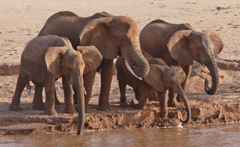
Elephant families like this one, taking a drink at Samburu National Reserve in Kenya, are lead by a matriarch and live their entire lives together as a family unit. (Courtesy of Richard A. Muller/Lawrence National Laboratory)
CURWOOD: How is it that the poachers kill these elephants. What do they do to them?
WASSER: During the poaching heyday we saw so many dead elephants all the time and you could tell they had been poached because their face was chopped off. People they kill the elephant and then they take a big ax and they chop the face off so that they can pull out the tusks. And we found one elephant that still had its tusks and we though, “ah finally an elephant that died that’s not from a poacher.” And I was in the field there for many many months there and passed that elephant time and time again as it decayed. And when it decayed one day I was looking at it and I saw a piece of rebar in there. And then I realized that that animal had been poached. It just didn’t die right away. It wandered and had a very slow horrible death.
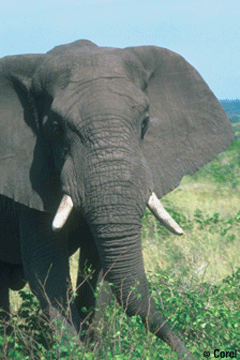
An African Elephant (Courtesy of USFWS)
CURWOOD: So, going back to this 1989 ban on trading, elephant populations went up and were doing pretty well, but now we’re back to a situation where what, almost ten percent of the elephant population is being killed every year at this point. What happened?
WASSER: Well, first of all it’s not true that the elephant populations went up. Because this is a big animal rights issue of having to kill entire herds of elephants that’s what’s been in the news for so long and this has created a false impression that there are too many elephants around the continent. The reason that there are so many elephants in South Africa is that the South African soldiers were up in Mozambique fighting guerrilla insurgents. And 60,000 elephants were killed in that time. The elephants from Mozambique made a beeline down to South Africa and they put up a fence around Kruger National Park. And meanwhile the park has 300 artificial waterholes throughout the park so tourists can see wildlife no matter where they go.
CURWOOD: Mmm hmm

Male baby elephants stay with their mothers until they are about 14. Females live in a familial group with their mothers, grandmothers, sisters and aunts their entire lives. (Courtesy of Richard A. Muller/Lawrence National Laboratory)
WASSER: Elephants self regulate their numbers by drought. When there’s a drought they stop reproducing. Well, in South Africa they don’t experience a drought when it occurs because there’s artificial waterholes everywhere. So they can’t self regulate their numbers and the whole area that they live in is enclosed. So when they’re crying that we need to cull our elephants because there’s too many of them. What they really need is to take the fences down and get rid of the artificial waterholes. And there is some very clever work being proposed by Rudy Van Arden in South Africa to create these mega-parks trans-boundry parks, where elephants are able to roam across several different countries. And there’s tons of habitat there for them to do that and it would be a cooperatively managed entity and that would solve these kinds of problems.
CURWOOD: So, there’s this call to cull quote “overpopulated elephants.” How is this done and how does this affect the elephants who are left behind?
WASSER: What they need to do is they need to cull entire family groups. If they kill just the adults the young are going to be orphaned and many will die quite a horrible death. What they do is they take helicopters and they fly over the herds of elephants and then the entire family stays really close together, close knit, and they move out of the herd and start to run away. And so now they know that they’ve got an intact family and then they fly over and they kill them all.
One of the big concerns about this is that the family groups that stay together in the tightest knit groups are the ones that are being killed. So it potentially is selecting for socially dysfunctional elephants.
CURWOOD: So, what is the solution to the elephant problem? I mean it seems that you either have too many in one place or too few in another.
WASSER: What we really need is to close down the ivory trade. In 1989 when the ivory ban went into effect we had a massive infusion of law enforcement in Africa that stopped poaching virtually over night. We can do that again very easily. What we’re talking about in each country are buying them 25 new vehicles, um new guns and ammunition, and new boots. At the same time the very small number of countries that have too many elephants right now in a compressed area need to be encouraged to start doing the kinds of wildlife management that will allow these elephants to once again self regulate themselves.
And lastly what is really important is to educate people in the Far East to start using alternatives besides ivory. And one of the things that we are proposing there is to get celebrities in the Far East to start coming out against usage of ivory. There was just a very very successful initiative by Wild Aid to stop the purchasing of shark fins in China. They got a very famous Chinese basketball player to come out against it. This kind of thing is remarkably effective in getting people to reevaluate their desires.
GELLERMAN: Samuel Wasser is the director of the Center for Conservation Biology at the University of Washington in Seattle. He spoke with Living on Earth’s Steve Curwood
[MUSIC: Nils Petter Molvaer “Kakonita” from ‘Solid Ether’ (ECM Records – 2000)]
Related links:
- "Megaparks for metapopulations: Addressing the causes of locally high elephant numbers in southern Africa" in Biological Conservation
- "Using DNA to track the origin of the largest ivory seizure since the 1989 trade ban" from the Proceedings of the National Academy of Sciences by the United States
- Center for Conservation Biology at the University of Washington
Climate Change Not So Sweet
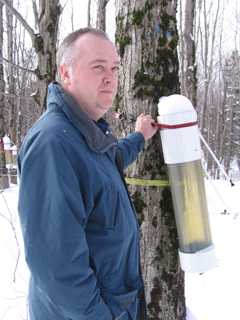
Dr. Timothy Perkins, director University of Vermont Proctor Maple Research Center standing next to a maple tree that was tapped as part of research to measure the sweetness of the sap during the season, and whether climate change will affect sugar content. (Photo: John Dillon)
GELLERMAN: This is the season for making maple syrup, here's the basic recipe: Stick a tap into any one of the millions of sugar maples that grow in the northeastern US and Canada. Gather about 40 gallons of the sap that drips out, and slowly boil it down to make one gallon of syrup. It’s easy but you need the cooperation of Mother Nature, the right rhythm of freezing nights and warm days in the winter and early spring to make the sap flow.
Even small changes in temperature can stop the run. And as the world warms, sugar-makers are worried that their livelihood – and their way of life – might be disappearing John Dillon of Vermont Public Radio has our report from the sugarbush.
DILLON: On the first day of spring, Burr Morse puts out the last of his three thousand taps. The bigger maples get two of the little spigots.
MORSE: Big old trees have coarse bark. Sometimes you just knock a piece of bark off.
[DRILLING NOISE AND SQUIRREL SOUNDS]
DILLON: The red squirrels chattering overhead don't seem to like the intrusion.
MORSE: Squirrels down there are kind of upset with what we're doing. It’s their tree.
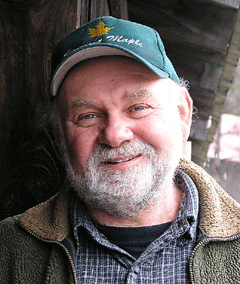
Burr Morse (Photo: Jeb Wallace-Brodeur/Times Argus)
DILLON: The Morse family has been tapping trees and making syrup since before the Civil War.
[CRUNCHING FOOTSTEPS ON SNOW]
DILLON: As he moves to the next tree, Morse says maple sugaring has become less predictable in recent years. March is the traditional start of sugaring here. But more recently, the first big sap flow has come in mid-winter.
MORSE: Late years, I’m talking the last 20 or so, ah we've had many, many early years, including last winter we had a big run in January.
DILLON: Morse describes himself as a reluctant believer in climate change. He's a seventh generation Vermonter, and Vermonters he says, usually don't get too upset about the weather.
MORSE: But finally, a couple years ago, I, I'd been through enough kind of poor sugar seasons in the last 20 years, and it was really beginning to pry on me that something was up with the weather. And then last Christmas I was cutting my Christmas trees most of the month of December in my short sleeve shirt. So, I just feel like it's happening, the climate is warming and I think the scientists have proof.
PERKINS: They're down there: those white things hanging on trees.
DILLON: One of those scientists is Dr. Timothy Perkins. In a grove of maples in the foothills of the Green Mountains, he's also gathering sap.
PERKINS: Right now there's 30.
[WALKING ON SNOW]
DILLON: Perkins is the director of the University of Vermont's Proctor Maple Research Center. Scientists at the center have collected sap to measure the ratio of sugar to water over time. The research may help sugar makers adapt to a warming world.
PERKINS: Sugar content changes during the season. Um, it changes from season to season, and it's quite a lot different from tree to tree so there are a number of variables that go into it. But certainly earlier in the year, what we would consider to be earlier in the year, the sugar content is much lower. We don't know how that will change with changing climate.

Dr. Timothy Perkins, director University of Vermont Proctor Maple Research Center standing next to a maple tree that was tapped as part of research to measure the sweetness of the sap during the season, and whether climate change will affect sugar content. (Photo: John Dillon)
DILLON: Skeptics argue that the recent mild winters in New England are due to natural variation.
But Perkins says it appears the climate is getting warmer over time. He's completed a separate study that uses 40 years of data from all over the northeast to answer the big question: What will rising temperatures mean for the timing and duration of the sugaring season?
The research shows that the sap is starting to run significantly earlier. The study also found that the length of the season decreased by about ten percent. It could be a make or break problem for the maple industry.
PERKINS: If the season itself is changing in duration, becoming shorter, then that will have a direct impact on yields, and will basically hurt producers in their pocketbook.
[BANQUET SOUNDS]
DILLON: At the Vermont Sugar Makers Association annual banquet earlier this winter, the meeting opened with a prayer. Maple prayer "Help us keep our maple trees healthy, and keep our product in the forefront of the world market."
Jacques Couture is a sugar maker from Westfield in northeastern Vermont. He thinks humans have a role in climate change.
COUTURE: As humankind we need to do all we can to not create emissions that might be furthering that along.
DILLON: The two thousand maple farmers in Vermont still make about half a million gallons a year – the most of any state.
Although the season is getting shorter and starting earlier, producers – like Couture – are starting to adapt with Yankee ingenuity. Tap holes dry up in about six weeks. That's a problem if the season starts in January and then cold weather returns and stops the run. So some sugar makers are using new micro taps that can stay in the tree longer. They also use vacuum systems that give nature a boost in getting the sap from the trees.
COUTURE: I don't think we're looking at something that's really bleak. We're seeing something happening, but I am still very upbeat on the Vermont maple industry and it's future.
DILLON: But scientists like Timothy Perkins of the University of Vermont say that in the long run global warming may mean far fewer maple trees in New England. The forest could change to a mix that's more adapted to warmer temperatures, like hickory and oak.
[LIGHTING SOUND]
DILLON: Burr Morse isn't ready to let that happen. As he fires up the evaporator to boil the day's sap run, he says sugar makers are uniquely qualified to speak out on climate change.
MORSE: I know there's naysayers about the global warming. And I've heard em talk and I’d love to believe them, but they haven't been sugar makers for the last 20 years and, fact is for the last 20 years we've had too many bad seasons caused by night freezes that weren't quite cold enough.
DILLON: Burr Morse says he's made the personal decision to take a more public stand in fighting the problem of climate change.
For Living on Earth, I'm John Dillon in East Montpelier, Vermont.
[SAP BOILING SOUNDS]
Related link:
Proctor Maple Research Center
[ELEPHANTS SNORING]
GELLERMAN: We leave you this week with some sleepy snufflufaguses...
[ELEPHANTS SNORING: “Slumbering Elephants” recorded by Chris Watson in the Maasai Mara, Kenya, Africa from ‘Outside The Circle of Fire’ (Touch – 2003)]
GELLERMAN: This particular pack of pachyderms isn't too partial about where they repose. Some even snore while snoozing near bystanders. Chris Watson caught these cat napping elephants in Kenya’s Maasai Mara Park. shhhhhhhhh...!
GELLERMAN: Living on Earth is produced by the World Media Foundation. Our crew includes Ashley Ahearn, Eileen Bolinsky, Ian Gray, Ingrid Lobet, Jennifer Percy, Emily Taylor, Peter Thomson and Jeff Young - with help from Bobby Bascomb, and Kelley Cronin. Our sound portrait of the Interfaith March for Climate Rescue was produced by our interns are Paige Doughty and Meghan Vigeant, and our technical director, Dennis Foley. Alison Lirish Dean composed our themes, our executive producer is Steve Curwood. You can find us at l-o-e dot o-r-g. I’m Bruce Gellerman, Thanks for listening. Shhhh, don’t wake up the elephants.
[ELEPHANTS SNORING: “Slumbering Elephants” recorded by Chris Watson in the Maasai Mara, Kenya, Africa from ‘Outside The Circle of Fire’ (Touch – 2003)]
ANNOUNCER: Funding for Living on Earth comes from the National Science Foundation, supporting coverage of emerging science; And Stonyfield Farm organic yogurt, smoothies and milk. Ten percent of profits are donated to efforts that help protect and restore the earth. Details at Stonyfield dot com. Support also comes from you our listeners, the Ford Foundation, the Oak Foundation, and the Saunders Hotel Group of Boston's Lennox and Copley Square Hotels. Serving you and the environment while helping preserve the past and protect the future, 800-225-7676.
Living on Earth wants to hear from you!
Living on Earth
62 Calef Highway, Suite 212
Lee, NH 03861
Telephone: 617-287-4121
E-mail: comments@loe.org
Newsletter [Click here]
Donate to Living on Earth!
Living on Earth is an independent media program and relies entirely on contributions from listeners and institutions supporting public service. Please donate now to preserve an independent environmental voice.
NewsletterLiving on Earth offers a weekly delivery of the show's rundown to your mailbox. Sign up for our newsletter today!
 Sailors For The Sea: Be the change you want to sea.
Sailors For The Sea: Be the change you want to sea.
 The Grantham Foundation for the Protection of the Environment: Committed to protecting and improving the health of the global environment.
The Grantham Foundation for the Protection of the Environment: Committed to protecting and improving the health of the global environment.
 Contribute to Living on Earth and receive, as our gift to you, an archival print of one of Mark Seth Lender's extraordinary wildlife photographs. Follow the link to see Mark's current collection of photographs.
Contribute to Living on Earth and receive, as our gift to you, an archival print of one of Mark Seth Lender's extraordinary wildlife photographs. Follow the link to see Mark's current collection of photographs.
 Buy a signed copy of Mark Seth Lender's book Smeagull the Seagull & support Living on Earth
Buy a signed copy of Mark Seth Lender's book Smeagull the Seagull & support Living on Earth

